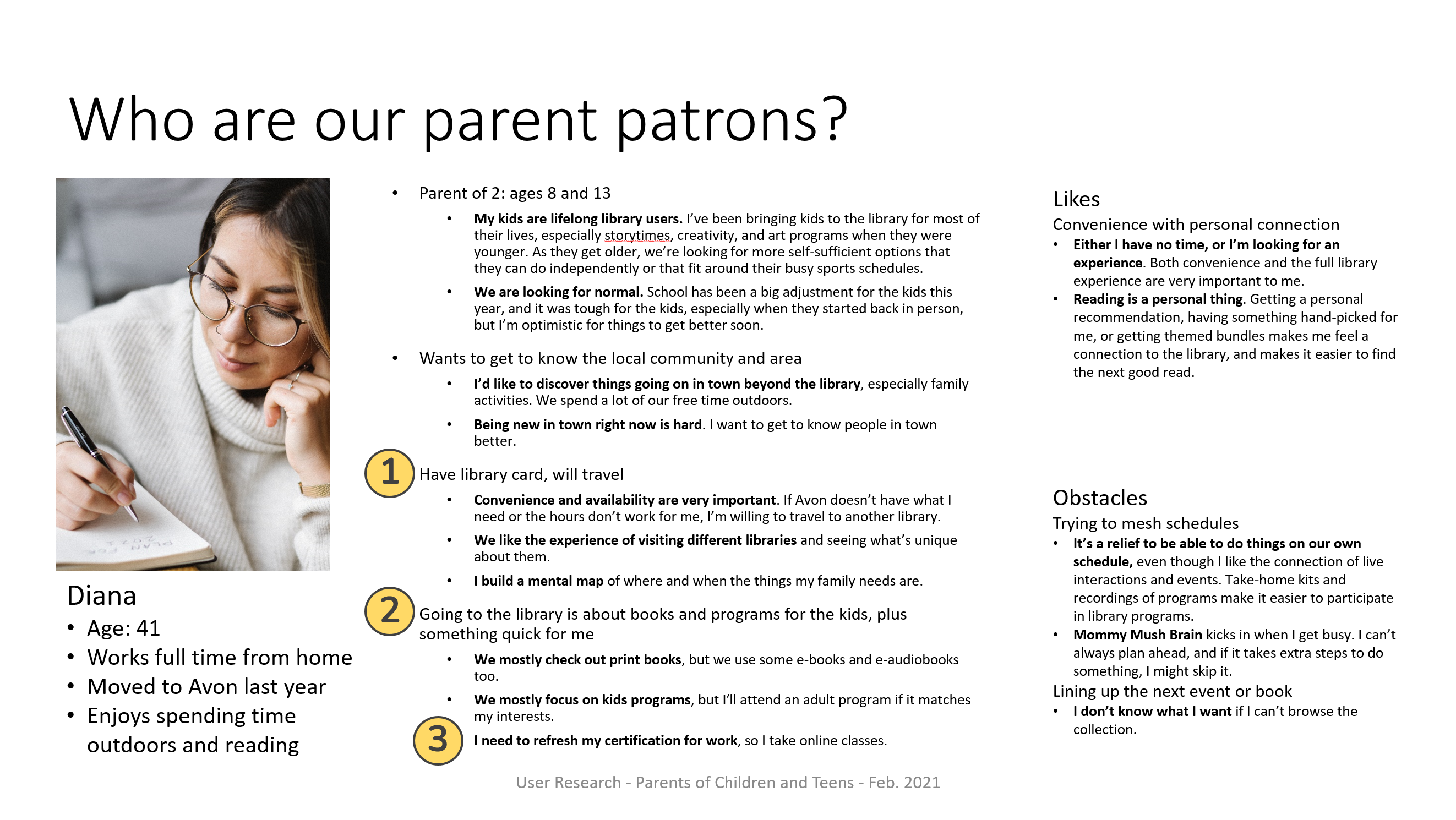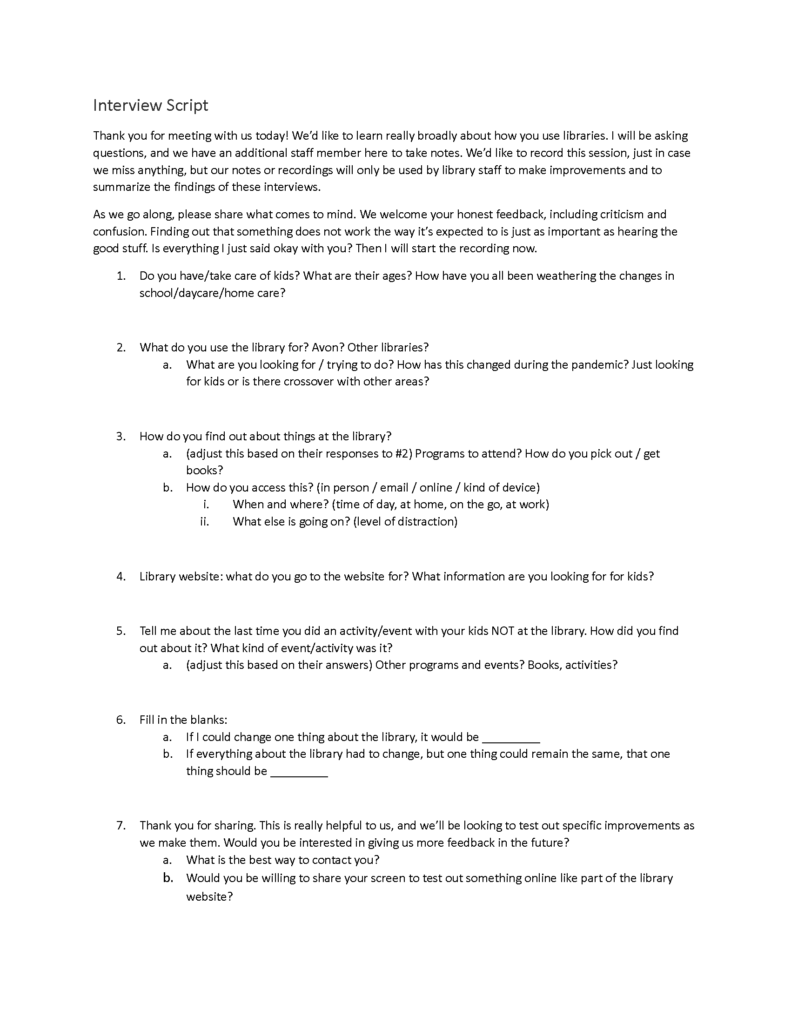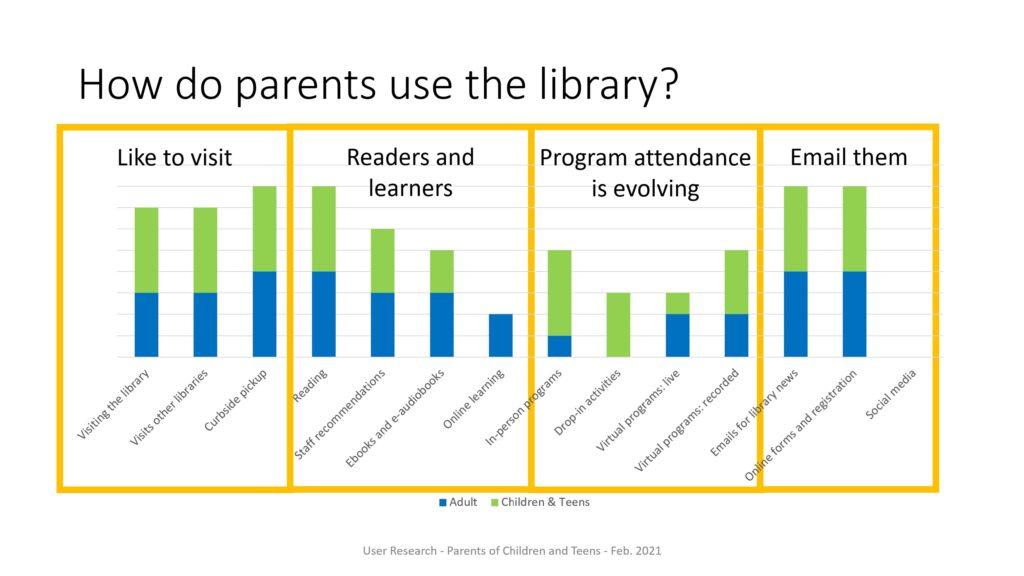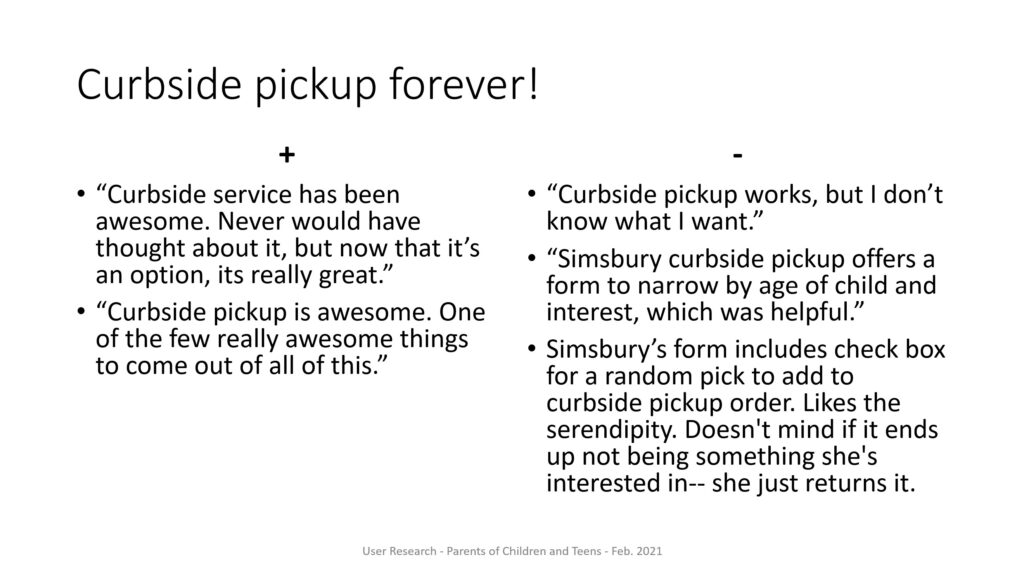Project Summary
I launched a pilot program to demonstrate the value of ongoing user research and testing during a time of uncertainty and change.

MY RESPONSIBILITIES
- Program strategy
- Remote user interviews
- Research synthesis
- Personas
- Presenting to stakeholders
TIMELINE
- Planning
- 2 weeks, December 2020
- Execution
- 3 weeks, February 2021
The Problem
Avon Free Public Library provides in-person and online library services to a small town in CT with a 30-person staff. In 2020, the pandemic drastically changed the way that patrons interact with the library and what they expect from the library.
In charting a path to reopening, we couldn’t assume that returning to the pre-pandemic normal would still meet patron needs.
We needed user feedback to help chart a new phase of library services.

The Solution
Together with the Library Technology Assistant, I proposed an ongoing user research program to
- recruit and interview patrons,
- share research insights during the planning and design process,
- and test services and products as they evolved.
But first, we needed the management team to see the value of user research.
We launched a pilot program, focusing on one segment of library patrons: parents of children and teens.
The Process
We needed to demonstrate the value of user research to the management team.

1. Establish a Framework
We set goals and criteria for the pilot program that would be sustainable long-term.
GOAL
How have people used the library before and during the pandemic?
How do they find out about library programs and news?
PARTICIPANTS
- Library users / non-users of varying ages, technology skill levels, and library use.
- The majority should be Avon residents and reflect the growing diversity of the town.
RECRUITING
- Pre-screening survey built in Google Survey
- Shared with Library email subscribers and Facebook
FORMAT
- 4-6 virtual exploratory interviews
- 30 minutes on Zoom and recorded for staff use
- One interviewer and one note taker in each session
We then surveyed users to find people interested in giving more in-depth feedback and focused on a single target research group: parents of children and teens.
Focusing on a single user group in this pilot program– parents of children and teens who uses multiple areas of the library– would give each library manager specific insights they could apply in their department.
Additional respondents’ contact information was saved for future research.
2. User Interviews
An interview script of open-ended, non-sequential questions kept the conversation flowing.
We conducted virtual interviews with the 4 parents who use the library. My teammate was the interviewer, and I took notes, recording phrases in the user’s own words as much as possible. I also flagged questions for follow up at the end, to allow for a natural conversational flow without interruptions.
After the interviews, I coded my notes into an Airtable database to identify trends.
Each note was a separate entry, so I could add tags, categorize positive and negative reactions, and highlight suggestions. Future research can also be added to Airtable and analyzed together.
From there, I could easily sort and group notes by theme to synthesize these interviews into a single parent persona.
3. Synthesis
I created the research report as a slideshow to distill insights into chunks of information as a tool for the management team.
From there, it was easy to customize the presentation for different types of stakeholders. Because each slide contains a complete idea, managers can also pull out and share slides that are most relevant to their teams.
The Parent Persona I created from this research highlighted actionable discoveries that the library could consider as it developed services.

- Library families travel to multiple libraries to get what they need and to see new places.
- If the Library doesn’t provide what families need in a convenient way, they will go elsewhere.
- Parents spend the most time in the Children’s section, but they are active readers too.
- Visual displays help parents find something quickly on their way to the Children’s Section.
- Parents are taking online classes through the library.
- How can we make it easier for them to find out about this service?
4. Presentation
When I presented to library management, I framed the research around the immediate problem we needed to solve.
How does the way that families use the library inform how we reopen services?
I summarized parents’ library experience in a memorable phrase so it would stick:
The “Whoosh” of Convenience & the “Woah” of Experience

- Low-contact services designed for the pandemic have been really convenient …But families miss spending the day at the library.
- How can we keep the convenience to allow families to focus on and enjoy their library experience?
The Outcome
The first step toward integrating UX into the organization
The management team found this research to be very helpful, and the program was approved to continue. However, there was still hesitancy to fully integrate it into the process.
“If we ask people what they want, and we can’t deliver it, we shouldn’t ask them.”
So, there is still some disconnect about what user research actually is (understanding how people accomplish their goals and how that could be improved), not simply asking what they want.
To address this hesitancy, we are integrating staff from other departments into the interview and testing process.
Benefitting a broader network of partners
With a research program in place, I conducted usability and accessibility testing for a mobile app being developed in 2021 for Library Connection, a consortium of 30 libraries. Through testing we were able to correct accessibility issues for low vision users and create an intuitive navigation of services.
Next Steps
- User research would continue with a new round of interviews or testing every 1-2 months to create additional personas and test new services and products earlier in the process.
- This pilot study used participants who were easy to find– those who subscribe to Library emails and can interview remotely. Future research must also include:
- Participants who do not have the ability or access to remote testing
- Town residents who do not use the Library
![Google survey screenshot. Text:
Library Feedback
Want to help improve library services? Let us know how you use the library with this 3 minute survey!
* Required
1. Do you use a public library? (Select all that apply) *
[checkboxes]
Avon
Other library
2. What do you use the library for? (Select all that apply) *
[checkboxes]
Programs and events
Checking out items (books/movies/etc)
eBooks or online resources
Other:
3. Are you a parent or caretaker? If so, select the age group of the child/children. (Select all that apply) *
[checkboxes]
0-4 years old
5-11 years old
12-18 years old
I don't have or take care of children
4. How do you prefer to find out about library news and programs? (Select all that apply) *
[checkboxes]
Website
Email
Social Media
Signs/Flyers at the library
Other:
5. What kind of device do you use? (Select all that apply) *
[checkboxes]
Desktop computer
Laptop
iPad/tablet
eReader
Smartphone
Other:
6. What is your age group? *
[dropdown]](https://jessnobledesigns.com/wp-content/uploads/2021/04/Screenshot_2021-04-04-Library-Feedback-401x1024.png)



